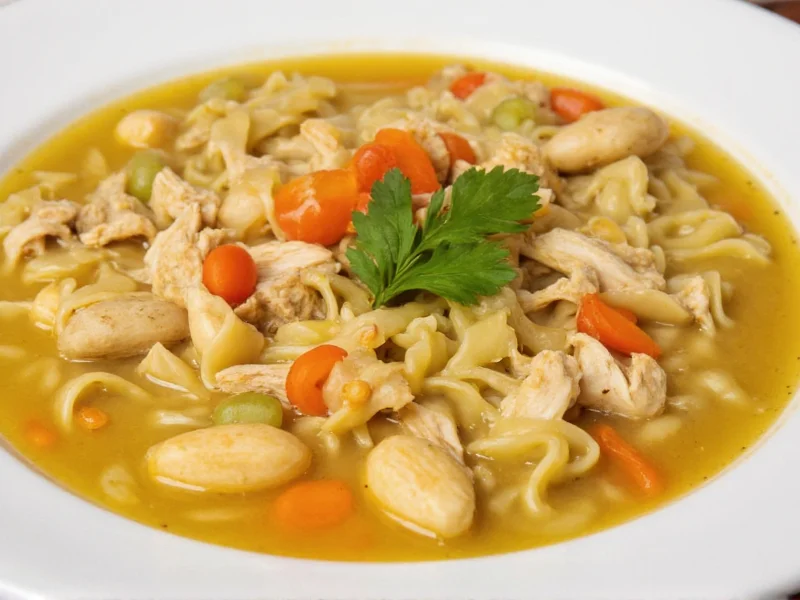When Campbell's Soup Company launched its Chicken Noodle Soup in 1934, it created what would become one of America's most enduring comfort food classics. The product emerged during the Great Depression when affordable, shelf-stable meal solutions were in high demand. Unlike many processed foods that have significantly altered their recipes over time, Campbell's Chicken Noodle Soup has maintained remarkable consistency in its fundamental formulation while introducing variations to meet evolving consumer preferences.
American Culinary Landmark
The significance of Campbell's Chicken Noodle Soup extends beyond its role as a simple meal option. During World War II, the U.S. military purchased massive quantities for troops overseas, cementing its place in American cultural consciousness. The distinctive red and white label design, standardized in 1962, has become one of the most recognizable food packages worldwide. Campbell's marketing campaigns throughout the 20th century positioned the soup as both a remedy for illness and a symbol of home comfort, creating powerful emotional associations that persist today.
Ingredient Composition and Variations
The original condensed formula contains a precise blend of ingredients that have defined its characteristic flavor profile. Understanding what's in Campbell's chicken noodle soup reveals why it has maintained such consistent appeal:
| Core Ingredients | Function | Notes |
|---|---|---|
| Chicken broth (condensed) | Base flavor | Made from chicken meat, water, salt, and natural flavors |
| Chicken meat | Protein source | Approximately 6% chicken by weight in original formula |
| Egg noodles | Carbohydrate component | Wheat flour, egg yolks, niacin, iron, B vitamins |
| Modified food starch | Thickening agent | Helps maintain consistency when diluted |
| Dehydrated vegetables | Flavor enhancement | Carrots, celery, onions in small quantities |
Over the decades, Campbell's has expanded its chicken noodle soup product line to accommodate different dietary needs and preparation preferences. The condensed version remains the most iconic, requiring addition of water or additional ingredients, while the "Home Style" line offers ready-to-eat formulations with more substantial ingredients. Recent additions include reduced-sodium options (containing 25-50% less sodium than original), organic varieties, and gluten-free alternatives for those with specific dietary requirements.
Nutritional Profile and Usage Guidelines
Understanding Campbell's chicken noodle soup nutrition facts helps consumers make informed choices. A standard 10.75-ounce can of condensed soup, when prepared with water according to directions, yields approximately two 1-cup servings:
- Calories: 60-70 per serving (varies by formulation)
- Sodium: 890mg in original (44% of daily value), 480mg in reduced-sodium
- Protein: 3-4g per serving
- Carbohydrates: 10-12g per serving
- Fat: 1g or less per serving
For optimal results when preparing Campbell's condensed chicken noodle soup, follow these professional recommendations:
- Always dilute with the recommended amount of water (typically one can of water per can of soup)
- For richer flavor, substitute water with additional chicken broth
- Add fresh ingredients like additional carrots, celery, or cooked chicken for enhanced texture
- Simmer gently rather than boiling vigorously to prevent noodle breakdown
- Store unused portions in refrigerator for up to 3-4 days
Cultural Impact and Modern Relevance
Campbell's Chicken Noodle Soup has transcended its status as merely a food product to become a cultural touchstone. Market research indicates that over 90% of American households have purchased this product at some point, with peak sales occurring during cold and flu season. The "chicken soup for the soul" concept popularized in the 1990s further elevated its status from simple comfort food to emotional remedy.
Despite evolving food trends and increased consumer focus on fresh, homemade meals, Campbell's Chicken Noodle Soup maintains steady sales. Recent adaptations include BPA-free can linings and gradual sodium reduction across product lines. Food historians note that its enduring popularity stems from the perfect balance of convenience, consistent flavor, and emotional resonance that few processed foods have achieved.
Frequently Asked Questions
What is the shelf life of Campbell's Chicken Noodle Soup?
Properly stored Campbell's Chicken Noodle Soup maintains best quality for 2-3 years past the printed date. The company states that canned soups remain safe indefinitely when stored in cool, dry conditions, though flavor and texture may degrade over time. Always check for bulging cans, leaks, or off-odors before consumption.
How does Campbell's condensed chicken noodle soup differ from their Home Style version?
The condensed version requires dilution with water or additional ingredients and has a thicker consistency before preparation. Home Style varieties are ready-to-eat with larger ingredient pieces, less sodium, and typically contain 30-50% more actual chicken and vegetables. The condensed formula has been virtually unchanged since 1934, while Home Style represents a more contemporary interpretation.
Is Campbell's Chicken Noodle Soup considered healthy?
While convenient and comforting, the original condensed version is relatively high in sodium (890mg per serving). The reduced-sodium version (480mg) offers a better option for those monitoring salt intake. Nutritionists suggest enhancing the nutritional profile by adding fresh vegetables, extra protein, and using low-sodium broth instead of water when preparing. It provides modest protein and can be part of balanced meal when supplemented with additional ingredients.
Why does Campbell's Chicken Noodle Soup contain modified food starch?
Modified food starch serves as a thickening agent that maintains consistent texture when the condensed soup is diluted with water. It prevents separation and ensures the soup maintains its characteristic viscosity throughout shelf life and during preparation. The starch used is typically derived from corn or tapioca and is processed to withstand the canning process without breaking down.
Has the recipe for Campbell's Chicken Noodle Soup changed significantly since its introduction?
The core recipe for Campbell's condensed Chicken Noodle Soup has remained remarkably consistent since 1934. The most significant changes have been reductions in sodium content (beginning in 2009), the introduction of BPA-free can linings (completed in 2017), and the addition of organic and reduced-sodium product lines. The fundamental combination of chicken broth, egg noodles, and small chicken pieces has remained unchanged for nearly 90 years.











 浙公网安备
33010002000092号
浙公网安备
33010002000092号 浙B2-20120091-4
浙B2-20120091-4